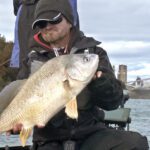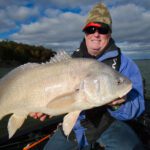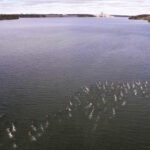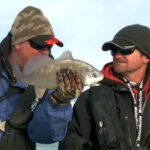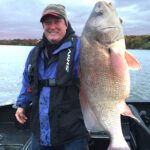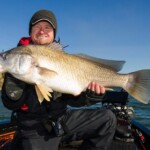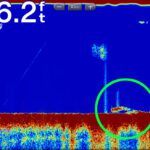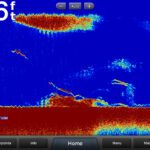On this Fish’n Canada episode, Pete decides to stray from the beaten fishing path. With Walleye, Northern Pike, Large- and Smallmouth Bass, Muskie, Trout, Salmon, Crappie, and so on available throughout this vast fish-filled country, the question is, why would someone stray?
“The word angling is defined as the sport or pastime of fishing with a rod and line,” reads Pete at the top of today’s episode. “It sounds pretty simple. However, once you start to branch out with technique, gear, geography, and species, it becomes a pretty broad subject.
“I’ve been on the water and angling since I was four or five years old, and not just for TV, but for fun and for building a broader knowledge as well. During those, let’s just say many years, I believe I’ve only tapped into a small portion of this great sport. This keeps me ready, willing and able to try something new.
“I’d like to think of this show as just that.”
BAY OF QUINTE
Pete was on the Bay of Quinte in southern Ontario, a place that’s world-renowned as a top tier Walleye fishery. On this shoot, he was joined by Kevin Lavers of Merland Park Cottages in the Picton area of Quinte.
Their intended species, however, was not the giant Walleye that swim in this great body of water, but actually a much lesser known fish, the Freshwater Drum (AKA the Sheephead). The Bay of Quinte is full of them!
ABOUT THE SHEEPHEAD:
- Freshwater Drum prefer clear to slightly stained water with a sand and gravel bottom and move deep during the summer, fall and winter.
- Records show some individual fish have lived to over 70 years old.
- Their only predators are birds and other fish during their 1st year and man from there after.
- Sheephead eat small fish, Zebra Mussels, and aquatic insects.
- Their throat contains “crushers”, which as the name says, crushes Zebra Mussel shells, exposing the fleshy meat.
- They don’t control Zebra Mussel populations, but they definitely help.
- The Sheephead is the only freshwater fish on which the lateral line runs right through its tail.
- It’s nick-named Croaker or Grunter for the weird grunting sounds the males can make by vibrating their swim bladder.
- Freshwater Drum are commercially harvested on a small basis for certain animal foods.
- Their flesh is not flaky like a Walleye, but is more firm like a Scallop; when prepared properly they can be very good table fare.
GRUNTERS
The Freshwater Drum — Aplodinotus grunniens — is a fish endemic to North and Central America. It is the only species in the genus Aplodinotus. The Freshwater Drum is a member of the family Sciaenidae, and is the only North American member of the group that inhabits freshwater for its entire life. Its generic name, Aplodinotus, comes from a Greek word meaning “single back”, and the specific epithet, grunniens, comes from a Latin word meaning “grunting”. The name is given to this fish because of the grunting noise that mature males make. This noise comes from a special set of muscles within the body cavity that vibrate against the swim bladder. The purpose of the grunting is unknown, but it is assumed to be linked to spawning, as it is present in only mature males.
THE WORLD RECORD
The Drum typically weighs 5–15 lb (2.3–6.8 kg). The world record was caught on Nickajack Lake in Tennessee, and weighed in at a massive 54 lb 8 oz (24.7 kg). The Freshwater Drum is gray or silvery in turbid waters, and more bronze or brown coloured in clearer waters. It is a deep bodied fish with a divided dorsal fin consisting of ten spines and 29–32 rays. It goes by a number of monikers, including shepherd’s pie, gray bass, Gasper goo, Gaspergou, gou, grunt, grunter, grinder, wuss fish, and croaker; but it is most commonly known as Sheephead or Sheepshead in parts of Canada, the United Kingdom, and the United States.
Freshwater Drum are the only North American member of their family to exclusively inhabit freshwater (freshwater family members in genera Pachyurus and Plagioscionare from South America, while Boesemania is Asian). Their great latitudinal distribution range goes as far north as the Hudson Bay and reaches as far south as Guatemala. Their longitudinal distribution goes as far east as the eastern Appalachians and stretches as far west as Texas, Kansas, and Oklahoma. Freshwater Drum are considered to be one of the most wide-ranging species in North America.
HOW THE BOYS CAUGHT ‘EM
Pete and Kevin had to vertical jig these hard fighters directly under the boat. Had they trolled, their numbers would have been abysmal. With cast and retrieve, they may have caught some fish, but nothing like vertically jigging. Blade baits, ice fishing jigs, and jigging spoons will all work on these fish. The key is to find an individual or small groups of fish on your electronics (they show up as huge arches) and work those fish until they bite.
“We found that letting the baits hit bottom was a key to getting strikes,” says Pete. “And when you lift into one, set hard and hang on!”
RECOMMENDED WATER BODIES TO SEARCH FOR SHEEPHEAD IN ONTARIO:
- Lake Ontario
- Lake Erie
- Niagara River
- St Lawrence River from Kingston to Brockville
- Detroit River
- St Clair River
- Lake St Clair
“This Eastern Ontario Sheephead adventure is the epitome of open-mindedness, broadening tunnel vision and taking things one step further,” says Pete. “Yes, I could have pulled crankbaits or drifted a jig and minnow through this world-class Walleye water, but instead, I took a chance on targeting a relatively unknown, intriguing and downright belligerent species of fish. A chance that I know I’ll never regret taking!”
Looks like Pete and Ang have a new quarry to delve into!




